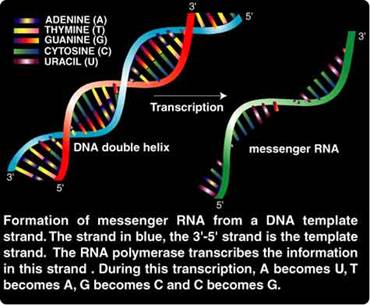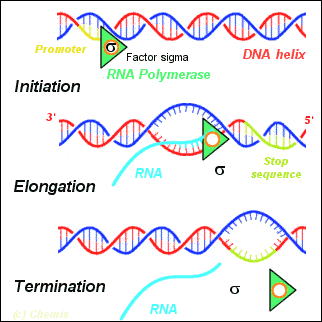CENTRAL
DOGMA
The
Central Dogma of genetics is: DNA is transcribed to RNA which is translated to protein. Protein is never back-translated to RNA or DNA; and
except... click here to read more

|
Transcription
is the process through which a DNA sequence is enzymatically copied by an RNA polymerase
to produce a complementary RNA. So to say, it is the transfer of genetic information from
DNA into RNA.
In the case of protein-encoding DNA, transcription
is the beginning of the process that ultimately leads to the translation of the genetic
code (via the mRNA intermediate) into a functional peptide or protein.
The stretch of DNA that is transcribed into an RNA
molecule is called a transcription unit. Transcription has some proofreading mechanisms,
but they are fewer and less effective than the controls for copying DNA; therefore,
transcription has a lower copying fidelity than DNA replication.

As in DNA replication, transcription
proceeds in the 5' - 3' direction (i.e. the old polymer is read in the 3' - 5' direction
and the new, complementary fragments are generated in the 5' - 3' direction).
Transcription is divided into 3 stages:
initiation, elongation and termination.

Initiation :
Transcription of RNA differs from DNA
synthesis in that only one strand of DNA, the template strand, is used to make mRNA.
Because transcription only proceeds in the 5' - 3' direction, it follows that the DNA
template strand that is used must be oriented in 3' - 5' (complementary) direction.
The strand that is not used as a template
strand is called the non-template strand or the coding strand. Thus, DNA exists as a
double strand, whereas RNA only exists as a single strand.
The difference is due to the fact that DNA
replication is semi-conservative, while transcription results in de novo production of a
single strand of RNA.
Transcription begins with the binding of
RNA polymerase to the promoter in DNA. In prokaryotes, the RNA polymerase is a core enzyme
consisting of five subunits: 2 a subunits, 1 ß subunit, 1 ß' subunit, and 1 ? subunit.
Transcription initiation is far more
complex in eukaryotes, the main difference being that eukaryotic polymerases do not
recognize directly their core promoter sequences.
Unlike DNA replication, transcription does
not need a primer to start.
The DNA unwinds and produces a small open
complex and synthesis begins on only the template strand.
Unlike DNA replication, mRNA transcription
can involve multiple RNA polymerases, so many mRNA molecules can be produced from a single
copy of the gene.
This step also involves a proofreading
mechanism that can replace an incorrectly added RNA molecule.
Termination:
- Bacteria use two different strategies for transcription
termination: in the "Rho-independent" type, RNA transcription stops when the
newly synthesized RNA molecule forms a hairpin loop, followed by a run of us, which makes
it detach from the DNA template. In the "Rho-dependent" type of termination, a
protein factor called "Rho" destabilizes the interaction between the template
and the mRNA, thus releasing the newly synthesized mRNA from the elongation complex.
- Transcription termination in eukaryotes is less well
understood. It involves cleavage of the nascent transcript, followed by
template-independent addition of As at its new 3' end, in a process called
Poly-adenylation.
|
TRANSLATION
Eventually the mature mRNA finds its way to a ribosome, where it is
translated into a protein, another biological polymer. In prokaryotic cells, which have no
nuclear compartment, the process... click
here to read more
 |




